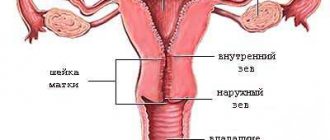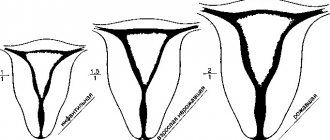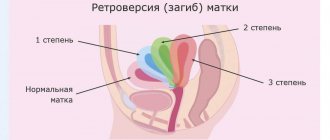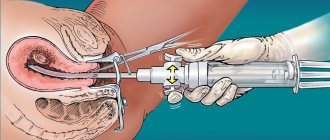Increased uterine tone at different stages of pregnancy
Pregnant women experience major adaptive changes in anatomy, physiology and the functioning of internal organs, which determine the normal course of pregnancy and successful childbirth.
The uterus, which has three layers: outer serous, inner epithelial, intermediate muscular - myometrium, undergoes radical changes. The middle layer is quite elastic, which allows it to stretch and contract during childbirth and return to its previous state after childbirth. However, against the background of the development of certain factors, contractile activity of the uterus may appear earlier than expected.
Various symptoms appear in the form of heaviness or nagging pain in the lower abdomen; in such cases, uterine hypertonicity is often diagnosed. Such a diagnosis is not a reason to panic, but this condition should not be considered the norm, so you need to make an appointment with a gynecologist as soon as possible.
Uterine tone during pregnancy - symptoms
The uterus is located in the pelvis between the rectum and bladder. The fallopian tubes are located symmetrically on both sides of the uterus, thanks to which the fertilized egg is transported. The uterus consists of three parts: the fundus, the body, and the cervix. The organ wall is formed by three types of tissue: perimeter, myometrium, endometrium.
At the moment of bearing a child, the uterus has the ability to increase 10 times, its muscles stretch, and its walls thicken. The main role in increasing the tone of the uterus is played by the myometrium, represented by a layer of smooth muscle. Throughout pregnancy, the myometrium remains relatively motionless, providing a suitable environment for the developing baby. In the short term, rhythmic and prolonged contractions of the muscle layer and expansion of the cervical region combine and physiological labor occurs.
If contractile activity of the uterus appears long before childbirth, in the first or second trimester, then the doctor often diagnoses uterine hypertonicity. Of course, such a phenomenon is not in all cases considered as a pathological process. But, if hypertonicity is observed all the time, this phenomenon can lead to critical consequences. The present symptoms of increased uterine tone during pregnancy can cause spontaneous abortion in the 1st trimester, and in the 2nd-3rd trimester lead to oxygen starvation of the fetus (hypoxia).
It is worth noting that the clinical manifestation of tone does not differ in characteristic signs; usually the expectant mother complains of discomfort and soreness in the lower abdomen, similar to menstrual pain.
The pain syndrome in most cases is not of a pronounced type, but can radiate to the lower back.
In the 2nd trimester of pregnancy, the symptoms of increased uterine tone do not differ much from the first, but upon palpation you can notice that the abdomen has become denser. In rare cases, a woman observes a spotting reddish-brown discharge from the vagina. If such a symptom develops, you should consult a doctor as an emergency.
It is also worth describing the symptoms of uterine hypertonicity during late pregnancy, in the 3rd trimester. At the end of the 38th week, tone has a completely different meaning and is considered as a manifestation of training contractions. This tone has the scientific name of a Braxton-Higgs contraction. Braxton Hicks contractions are designed to strengthen the muscles of the uterus in preparation for subsequent labor. Contractions usually last about 30-45 seconds. However, in the eighth and ninth months of pregnancy they can even occur every 20-30 minutes. Braxton Hicks contractions are called “predictive contractions” and have an average duration of no more than two minutes.
In some women, hypertonicity is asymptomatic and is diagnosed during ultrasound examination.
How to notice hypertonicity?
For a favorable pregnancy, free growth of the fetus and its development, as well as the successful formation of the placenta and everything connected with it, the uterus must be relaxed. Tension of the myometrium, that is, the tone of the uterus, is extremely undesirable, especially in the first weeks of pregnancy, when the baby's place is just being formed and the embryo is fixed inside. Usually, with this symptom, the expectant mother experiences sensations similar to menstrual pain - pulling in the lower abdomen, pain in the lower back and tailbone. There may even be blood discharge, not necessarily a bright red color. If the uterus tenses for a short period of time, this does not harm the mother and her fetus. However, if the tone is delayed, this is already called hypertonicity and is a very dangerous condition.
Painful sensations in the area of the uterus, especially if there is any non-white discharge, is a reason to urgently consult a doctor. In the first trimester, the gynecologist can easily determine the tone by examining the woman on the chair, and an ultrasound will confirm or refute the conclusion “hypertonicity of the myometrium.” Often, the patient herself does not feel the increased tone, only the doctor notices it during a routine examination, so consultations with a gynecologist during the entire period of bearing a child should not be missed.
It is important to understand that hypertension is the real danger for pregnancy. There is a risk of abruption of the unformed placenta, which can lead to miscarriage or fetal death due to lack of oxygen and necessary substances.
In the second and third trimesters, a pregnant woman herself can recognize the tone of the uterus. The abdomen suddenly tenses up, becomes hard, painful sensations and even small contractions appear. At this stage, due to hypertension, the pressure on the amniotic sac increases. The cervix may open prematurely, which risks causing premature birth.
Reasons for increased uterine tone during pregnancy
The causes of uterine tone during pregnancy are varied, for example, changes in hormonal levels, in which there is a deficiency of progesterone or an increase in the concentration of testosterone. A disease or pathological process, somatic disorders and even stress can also be a provoking factor.
An increase in the contractile activity of the reproductive organ may be observed for the following reasons:
- Lack of progesterone
- Intense physical activity
- Stress
- Oncological diseases
- Hormonal disorders
- Acute infections
- Activation of chronic processes
- Alcohol abuse, smoking
- Genetic disorders in the fetus
- Micronutrient deficiency
- Large fetus, several fetuses in the uterus
- Large volume of amniotic fluid
- Increased blood clotting
The most important role of progesterone is to prepare the uterus for embryo implantation. Thanks to this, the mucous membrane thickens and expands, its blood supply becomes more intense, and nutrients accumulate. Progesterone also allows the uterus to gradually grow and limits its contractility, which allows pregnancy to proceed physiologically. But a reduced level of progesterone disrupts the natural course of pregnancy and can cause uterine hypertonicity.
Other factors:
- Psychological problems
- Long trips
- Flying an airplane
- Overweight
- Age over 35 years
- Violation of fetal position
- Intestinal motility disorder
- History of miscarriages
Separately, doctors note a diet that negatively affects the functioning of the gastrointestinal tract, which often becomes the cause of hypertension. Doctors recommend excluding the following foods:
- Legumes, cabbage: provoke gas formation.
- Blue cheese: contains mushrooms that are dangerous for expectant mothers.
- Coffee: intensively removes fluid from the body, which can cause hypertension.
- Raw eggs: are a potential source of salmonellosis and cause disruption of the digestive tract.
Many experts argue that tone is very dangerous, and not as harmless as it seems. In fact, such a condition is not always dangerous; contractile activity may be present normally.
But with such clinical manifestations, you should consult a gynecologist to determine possible deviations, as well as decide on tactics to combat them. If you do not pay attention to hypertonicity and do not take timely measures, the long-awaited pregnancy may end in miscarriage or severe fetal hypoxia.
The tone of the uterus during pregnancy in the earliest stages almost always requires appropriate intervention. Because in the first trimester there is the greatest risk of sudden miscarriage. If moderate hypertonicity is present, the woman is recommended to take antispasmodics. In cases where increased tone is caused by hormonal disorders, products containing progestin are prescribed.
Increased uterine tone in the second trimester of pregnancy in most cases is part of the natural process of preparing the body for labor, but it can also be a sign of pathology.
If clinical signs of hypertonicity develop, you should inform your doctor. As a treatment, it is possible to prescribe B vitamins and special sets of exercises.
Diagnostics
Methods for diagnosing increased tone include:
Examination, palpation of the abdomen. Normally, a pregnant woman’s abdomen is soft, but with hypertonicity it becomes hard and tense.
Ultrasound examination, which makes it possible to determine the degree and extent of thickening of the muscular layer of the uterus. Ultrasound reveals the localization of muscle tension in the anterior or posterior wall of the myometrium of 1st and 2nd degree.
Tonuometry using a special device that determines the state of muscle tone. In practice, it is rarely used, since diagnosing uterine hypertonicity during pregnancy is not difficult.
Diagnosis of hypertension and related diseases
There are several methods for diagnostic confirmation of the presence of hypertonicity. Ultrasound examination is considered the simplest and most accessible. Ultrasound allows you to assess the condition of the uterine muscles, determines possible pathological processes and directly indicates ongoing hypertonicity.
Another, more modern method of determining tone is tonusometry. The essence of the diagnostic method is that sensors are placed on the woman’s stomach, which send a signal to a special device that visualizes the presence of tone.
If hypertension is confirmed, the doctor prescribes a number of additional studies:
- General clinical analysis of blood and urine
- Determination of hormone levels in the blood
- Diagnostics of blood clotting
- Research for STDs
Uterine tone in the 3rd trimester
Uterine tone in the third trimester is difficult to distinguish from preparatory contractions. Therefore, when a typical clinical picture of tone develops, cardiotocography is prescribed. This is monitoring the fetal heart rate along with simultaneous recording of contractions of the reproductive organ. The examination is carried out as part of intensive prenatal care and allows us to identify early changes that threaten the life of the fetus.
The study is initially conducted as a stress test. It involves recording fetal heart function and uterine contractions for 30 minutes. The test can be extended up to 60 minutes.
How to relieve uterine tone, what to do if it increases
What to do and how to properly remove excess uterine tone during pregnancy? If the problem is of an unexpressed nature, you can try to relieve it without resorting to taking medications. If symptoms develop, light physical activity such as walking or swimming is recommended. You can also do the following exercise: tilt your head as low as possible, relax, take a few deep breaths and exhales. All this can be done only after consulting a gynecologist.
Doctors also recommend attending classes for pregnant women. Experts will show you what exercises can be used to reduce tone and how to help the body prepare for further childbirth. Even a slight tone does not cancel a visit to the gynecologist.
Effective treatments
When entering the hospital to eliminate increased tone, a woman first undergoes diagnostics, based on the results of which the doctor draws up a treatment plan. Today, the answer to the question of how to treat uterine hypertonicity is the use of medications.
Among the main medications are:
- hormonal substances;
- antispasmodics;
- preparations containing magnesium.
Also, the main advice on relieving uterine hypertonicity is to adhere to strict bed rest, walk in the fresh air, take sedative medications (as prescribed by a doctor) and control sugar, heart rate, and blood pressure.
In addition, in order to protect yourself from the reoccurrence of the problem, you should consult a doctor about nutrition and find out which foods increase the tone of the uterus. Among the main ones are:
- drinks containing caffeine, including strong tea;
- blue cheese;
- seafood that cannot be processed;
- eggs;
- alcoholic drinks.
Now that you know what you shouldn’t do if you have uterine hypertonicity, you can safely exclude forbidden foods from your diet and protect yourself from possible pathologies.










